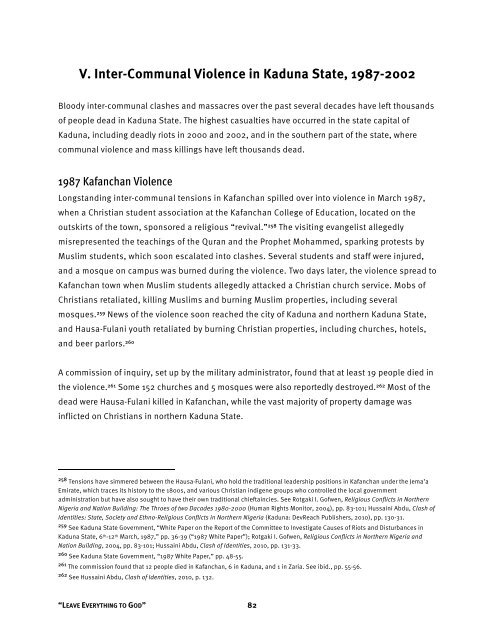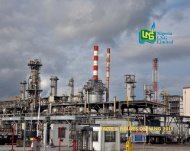You also want an ePaper? Increase the reach of your titles
YUMPU automatically turns print PDFs into web optimized ePapers that Google loves.
V. Inter-Communal Violence in Kaduna State, 1987-2002<br />
Bloody inter-communal clashes and massacres over the past several decades have left thousands<br />
of people dead in Kaduna State. The highest casualties have occurred in the state capital of<br />
Kaduna, including deadly riots in 2000 and 2002, and in the southern part of the state, where<br />
communal violence and mass killings have left thousands dead.<br />
1987 Kafanchan Violence<br />
Longstanding inter-communal tensions in Kafanchan spilled over into violence in March 1987,<br />
when a Christian student association at the Kafanchan College of Education, located on the<br />
outskirts of the town, sponsored a religious “revival.” 258 The visiting evangelist allegedly<br />
misrepresented the teachings of the Quran and the Prophet Mohammed, sparking protests by<br />
Muslim students, which soon escalated into clashes. Several students and staff were injured,<br />
and a mosque on campus was burned during the violence. Two days later, the violence spread to<br />
Kafanchan town when Muslim students allegedly attacked a Christian church service. Mobs of<br />
Christians retaliated, killing Muslims and burning Muslim properties, including several<br />
mosques. 259 News of the violence soon reached the city of Kaduna and northern Kaduna State,<br />
and Hausa-Fulani youth retaliated by burning Christian properties, including churches, hotels,<br />
and beer parlors. 260<br />
A commission of inquiry, set up by the military administrator, found that at least 19 people died in<br />
the violence. 261 Some 152 churches and 5 mosques were also reportedly destroyed. 262 Most of the<br />
dead were Hausa-Fulani killed in Kafanchan, while the vast majority of property damage was<br />
inflicted on Christians in northern Kaduna State.<br />
258 Tensions have simmered between the Hausa-Fulani, who hold the traditional leadership positions in Kafanchan under the Jema’a<br />
Emirate, which traces its history to the 1800s, and various Christian indigene groups who controlled the local government<br />
administration but have also sought to have their own traditional chieftaincies. See Rotgaki I. Gofwen, Religious Conflicts in Northern<br />
Nigeria and Nation Building: The Throes of two Dacades 1980-2000 (Human Rights Monitor, 2004), pp. 83-101; Hussaini Abdu, Clash of<br />
Identities: State, Society and Ethno-Religious Conflicts in Northern Nigeria (Kaduna: DevReach Publishers, 2010), pp. 130-31.<br />
259 See Kaduna State Government, “White Paper on the Report of the Committee to Investigate Causes of Riots and Disturbances in<br />
Kaduna State, 6 th -12 th March, 1987,” pp. 36-39 (“1987 White Paper”); Rotgaki I. Gofwen, Religious Conflicts in Northern Nigeria and<br />
Nation Building, 2004, pp. 83-101; Hussaini Abdu, Clash of Identities, 2010, pp. 131-33.<br />
260 See Kaduna State Government, “1987 White Paper,” pp. 48-55.<br />
261 The commission found that 12 people died in Kafanchan, 6 in Kaduna, and 1 in Zaria. See ibid., pp. 55-56.<br />
262 See Hussaini Abdu, Clash of Identities, 2010, p. 132.<br />
“LEAVE EVERYTHING TO GOD” 82




